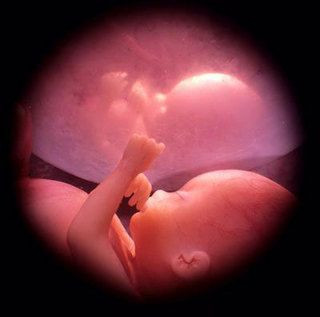Babies Can Predict Movement While Still In The Womb: New Test Of Healthy Fetal Development?

Using four-dimensional (4D) ultrasonography, researchers discovered that while still in the womb, babies are able to predict the way their hands move towards their mouths — rather than simply react, as was previously though. This behavior only occurred, though, after a fetus entered the later stages of gestation, in contrast to their abilities earlier in a pregnancy. This new knowledge of fetal anticipation of touch could generally improve understanding of babies, the researchers noted, especially of those born prematurely.
“Increased touching of the lower part of the face and mouth in fetuses could be an indicator of brain development necessary for healthy development, including preparedness for social interaction, self-soothing, and feeding,” Nadja Reissland, lead author and professor in the Department of Psychology at Durham University, stated in a press release. The research was published in Developmental Psychobiology.
Behavior Linked to Development
To conduct their study, the team of researchers carried out a total of 60 scans of 15 healthy fetuses at monthly intervals between 24 weeks and 36 weeks gestation. Eight girls and seven boys were chosen in order to investigate whether any differences exist across genders. In the earlier stages of gestation the fetuses frequently touched the upper part and sides of their heads, yet as they gradually matured, the fetuses began to increasingly touch the lower, more sensitive, part of their faces, including the mouth. By 36 weeks, a significantly larger proportion had begun to open their mouths before their hands came into contact.
Boys and girls exhibited no differences in behavior. The researchers hypothesized that increased sensitivity around a fetus’ mouth at a later stage of pregnancy could mean that they have more “awareness” of mouth movement. They added this could be an indicator of whether a baby is prepared for feeding; the findings might also improve understanding of an individual baby’s readiness to interact socially as well as a newborn's ability to calm him or herself by sucking on the thumb or fingers.
Index of Fetal Health
“The findings could provide more information about when babies are ready to engage with their environment, especially if born prematurely,” Reissland stated in a press release.
“This effect is likely to be evolutionally determined, preparing the child for life outside the womb,” Brian Francis, co-author and Professor of Social Statistics at Lancaster University, stated in a press release. “Building on these findings, future research could lead to more understanding about how the child is prepared prenatally for life, including their ability to engage with their social environment, regulate stimulation and being ready to take a breast or bottle.”
The current study builds on previous research into fetal development conducted by the same researchers at these two British universities. Previously, they published a study that showed how unborn babies ‘practice’ facial expressions while in the womb. For this considerably smaller study, the researchers scanned two healthy fetuses at different gestational stages during both the second and third trimester. They soon discovered two distinct facial movements they described as “cry-face-gestalt” and “laughter-gestalt.” According to the researchers, each expression was composed of up to seven distinct facial movements and both possibly arose to prepare the unborn babies for communicating after birth.
“We propose that there is considerable potential of this method for assessing fetal development: Subsequent discrimination of normal and abnormal fetal facial development might identify health problems in utero,” the researchers stated in their conclusion.
Sources: Reissland N, Francis B, Aydin E, et al. The development of anticipation in the fetus: a longitudinal account of human fetal mouth movements in reaction to and anticipation of touch. Developmental psychobiology. 2013.
Reissland N, Francis B, Mason J, et al. Do Facial Expressions Develop before Birth? PLoS ONE. 2011.
Published by Medicaldaily.com



























